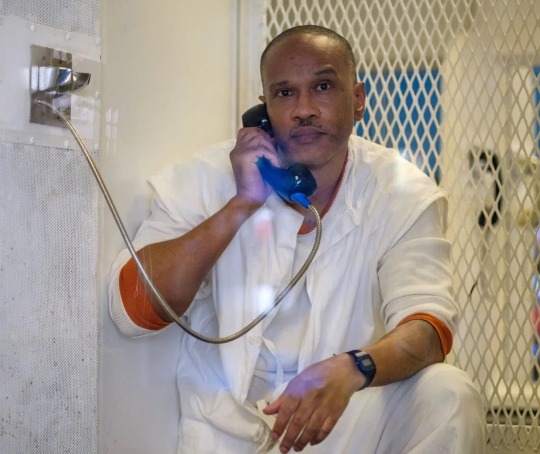#incarcerated people
Text
Legality ≠ morality
#abolition#abolitionist#acab1312#acab#abolish the police#abolish the state#abolish police#abolish ice#abolish prisons#abolish family policing#leftist theory#leftist#abolish landlords#abolish capitalism#abolish the supreme court#1312#human rights#incarcerated people#incarceration#cripple punk#cripplepunk#chronically couchbound#fuck 12
278 notes
·
View notes
Text
40% of the male population in Palestine has spent time in an Israeli prison.
𝟒𝟎 𝐅𝐔𝐂𝐊𝐈𝐍𝐆 𝐏𝐄𝐑𝐂𝐄𝐍𝐓. And this is before the current conflict. To put that in perspective American is frequently said to have the "highest incarceration rate in the world" and the estimate is that 9% of men will be in prison at some point here (still insanely high). Who could live in these conditions?! Of course Palestine is fighting back, who wouldn't?!
#palestine#free palestine#from the river to the sea palestine will be free#fuck israel#gaza#free gaza#israel#genocide#israel is a terrorist state#incarceration#incarcerated people#colonialism#settler colonialism#israeli apartheid#israeli terrorism
55 notes
·
View notes
Text
‘Books keep our minds free’: US prisons ban reading materials at alarming pace
New PEN America data reveals incarcerated persons are being robbed of magazines and even recipe books
by Olivia Empson

Reading bans are rising at an alarming rate in prisons across the country, with new PEN America data revealing that those incarcerated are being robbed of the occasional magazine and even recipe books on how to make ramen.
For almost 22 years, Zeke Caligiuri subscribed to the New Yorker magazine from prison in Minnesota. He was meant to receive 52 annual issues but claimed during his sentencing to have never gotten the full amount. Instead, a non-delivery notice with vague wording would arrive at the prison post room, sometimes flagging an advertisement that was deemed inappropriate or just one article in an issue of many. After searching for information about what he couldn’t read, Caligiuri would sink into a period of overwhelming defeat.
“I realized that my world needed to get bigger,” he said. “But the things I needed to see and know were being held back.”
During this time, the words of New Yorker writers like Adam Gopnik, Ariel Levy and Emily Nussbaum were means of escaping the monotony of incarceration. Prison was programmed by a rigorous schedule, with days hardly extending beyond what was for lunch or when inmates could watch television. Searching for meaning, Caligiuri sometimes slept on the bunks with a book next to his head. When he could get it, poetry was the first thing he read when he woke up.
“If you take the books and culture out of these places, you have a zoo,” he said. “Language is the building block of creation. For me, in prison, it was the biggest thing. Words were the only thing connecting me with the world, with my family, and with my community.”
READ MORE
59 notes
·
View notes
Text

Incarcerated women photographed by Sofia Moro in 2006.
31 notes
·
View notes
Text

#louisiana#usa news#usa#america#prison#prison capital#earth#world#incarcerated people#incarcerated women#incarceration#oppression#repression#genocide joe#joe biden#biden administration#president biden#biden#class war#ausgov#politas#auspol#tasgov#taspol#australia#fuck neoliberals#neoliberal capitalism#anthony albanese#albanese government#fascism
16 notes
·
View notes
Text
95 notes
·
View notes
Text
Something that learned from working with incarcerated people.
In prisons, custody officers, prison staff, and outside contractors such as myself aren't allowed to touch incarcerated people other than handshakes. Incarcerated people aren't allowed to touch each other in most cases, too. Some of this is for reasons that make sense (reducing sexual and physical violence), but it's damaging. What do you think it does to you if your love language is touch and you're incarcerated for years? How do you think it would effect you if every time you went to put your arm around someone or hug them, it was met with being screamed at or punished in other ways?
The thing I learned from incarcerated people is that there are a thousand ways to shake someone's hand. There has been so much meaningful communication exchanged through just a handshake. Holding onto my hand for just a moment longer than normal, enfolding my entire hand in both of theirs to shake it as a symbolic way of giving me a hug, squeezing my hand a few times, the list can go on.
When it's the only type of touch a human being is allowed for sometimes 16 years, people will pour their absolute soul into that one method of communication that people outside of the gate do as a just a passing formality. In prison love is exchanged through handshakes.
24 notes
·
View notes
Text
#tiktok#more perfect union#tw slavery#slavery#modern slavery#prison#incarcerated people#incarceration#capitalism#late stage capitalism#capitalism kills#modern day slavery#prison labor
7 notes
·
View notes
Text
“When someone asks me to rate the various libraries that I have experienced over my fifty-some years in this life, they will look at me funny when I simply say, “Sacred.”"
8 notes
·
View notes
Text
wage slaves: reimagining rehabilitation in busyland
In contemporary society, a pervasive belief links an individual's worth to their productivity and economic output. This mindset, deeply ingrained in cultural and societal norms, often leads people to equate self-worth with professional achievements and material success. Josef Pieper, in "Leisure: The Basis of Culture," warns against this trend, noting how the loss of leisure distorts our attitude toward life. Pieper argues that leisure isn't just for those who can afford it but is a virtue exemplified by those who give everything they do the time it deserves, or even more.
This narrow perspective on worth and productivity overlooks the intrinsic value of leisure time in promoting overall well-being. David Graeber, in "Bullshit Jobs: A Theory," highlights a widespread sense that much of what we do in modern economies lacks purpose. While productivity and economic success are important, they represent only a fraction of a fulfilling life. The relentless pursuit of productivity often leads to burnout, stress, and a sense of emptiness, undermining mental and emotional health.
One of the most visible signs of this societal pressure is the glorification of busyness and the prevalence of long working hours. Michelle Alexander, in "The New Jim Crow," observes a fundamental shift in the criminal justice system's focus, from preventing and punishing crime to managing and controlling the dispossessed. In the pursuit of professional success, individuals often sacrifice personal time, creating a chronic imbalance between work and leisure.
Societal norms further reinforce this prioritization of work over leisure. From glamorizing "hustle culture" on social media to corporate cultures that reward constant availability, there's a pervasive message that success requires relentless dedication and sacrifice. Many feel compelled to constantly strive for productivity, fearing any moment of leisure or relaxation is a wasted opportunity for advancement.
This prevailing belief not only undermines well-being but also perpetuates a cycle of overwork and burnout. By neglecting the intrinsic value of leisure time, society risks sacrificing the qualities that make life worth living: joy, creativity, and connection. Challenging this perspective is essential, advocating for a balanced approach recognizing the importance of both work and leisure in fostering holistic well-being.
Acknowledging the ideology linking worth to productivity prompts a reassessment of the treatment of incarcerated individuals. The current system often exploits prisoners as cheap labor, perpetuating overwork and devaluing their humanity. Recognizing the intrinsic value of leisure and personal fulfillment challenges the notion that productivity defines one's worth. This shift urges advocacy for rehabilitation and education programs within prisons, providing opportunities for growth rather than exploitation.
Investing in rehabilitation and education programs has shown significant societal benefits, reducing recidivism and fostering successful reintegration into society. Advocating for such programs acknowledges the inherent worth and potential for redemption in every individual. Disrupting ideologies that exploit vulnerable populations allows for alternative approaches to incarceration and rehabilitation, centered on restorative justice and human dignity.
Accepting the status quo of using prisoners as slave labor perpetuates the belief that disrupting the 9-5 structure is unviable. However, recognizing the intrinsic value of leisure challenges this narrative, paving the way for a more equitable and humane approach to incarceration and labor practices, prioritizing the well-being and dignity of all individuals.
#leisure#writing#journey#time#humanity#productivity#incarceration#incarcerated people#9 5#nine to five#jobs#hustle culture#hustle#culture#portfolio
2 notes
·
View notes
Text
Something that I think escapes a lot of people is that US modern-day prisons are work camps(if prisoners are lucky). They are concentration camps for undesirables. They are abusive in nature and not rehabilitative in any way.
Many don’t make it out alive or without suffering from SA and other trauma. If and/or when they do make it out, they are faced with a life with no opportunity and limited possibilities.

#prison abolition#prison industrial complex#there are better ways#incarcerated people#prisoner rights#human rights
8 notes
·
View notes
Text

Portland, OR
Age: 24
Arrest Date: Tue 4/11
Time: 5:54 PM
Status: OUT
Idaho State Police
M Failure to Appear for Misdemeanor Citation
I19-3901A Warrant
10 notes
·
View notes
Text
The Dungeons & Dragons Players of Death Row
For a group of men in a Texas prison, the fantasy game became a lifeline — to their imaginations, and to one another.

When Ford first overheard the men on the old Huntsville death row playing D.&D., they were engaged in a fast, high-octane version. The gamers were members of the Mexican Mafia, an insular crew that let Ford into their circle after they realized he could draw. The gang’s leader, Spider, pulled some strings, Ford recalls, and got him moved to a neighboring cell to serve as his personal artist. Ford earned some money drawing intricate Aztec designs in ink. He also began to join their D.&D. sessions, eventually becoming a Dungeon Master and running games all over the row.
Playing Dungeons & Dragons is more difficult in prison than almost anywhere else. Just as in the free world, each gaming session can last for hours and is part of a larger campaign that often stretches on for months or years. But in prison, players can’t just look up the game rules online. The hard-bound manuals that detail settings, characters and spells are expensive and can be difficult to get past mailroom censors. Some states ban books about the game altogether, while others prohibit anything with a hard cover. Books with maps are generally forbidden, and dice are often considered contraband, because they can be used for gambling. Prisoners frequently replace them with game spinners crafted out of paper and typewriter parts.
READ MORE
When I worked for TSR, Inc. back in the day, the letters from prisoners requesting D&D books and modules came to my desk. You would be surprised how many we got. Getting product to prisoners was difficult and each prison had different policies. The letters were always from prisoners, not prison staff or librarians. The prisoners had to piece together what their local policy or issue was and how to get around it. Most could not. Shipping products directly to a prisoner, even for free, was usually out of the question. Prisons looked at D&D not as a game but as a tool for planning escapes. (Terms like "dungeon crawl" on the product didn't help.) The majority of the time the only viable option was to get the local prison library to stock it. I would do my best to track down the local supplier for the prison in question and forward the information to our sales rep from Random House for that territory to reach out. It was more likely the Random House rep rather than our own Hobby Channel reps would have a relationship with the librarian or prison purchasing board for their other books. In the 10 years I was involved in the sales and marketing of Dungeons & Dragons I received 3 thank you letters for getting the game into a prison. ~ eP
#dungeons and dragons#mental health#prisons and jails#librarians#incarcerated people#literacy#prison library#role playing games#ttrpg community
75 notes
·
View notes
Photo

Self Portrait with Tumors, 2021, Collaged paint samples on paper, by Dominic Marak
Art Against the Odds - Wisconsin Prison Art Exhibit at the Milwaukee Institute of Art and Design, January 19th through March 11th, 2023
Dominic Marak was diagnosed with terminal cancer while he was incarcerated. He died at the age of 55 in 2021, the same year he completed this self-portrait.
Photos by Charles Reeza
7 notes
·
View notes
Text







💜 Balkan Bridge winter donation appeal 💜
🗓 Announcement! Thursday #b2812 / 28.12.2023 🗓
🔥Solidarity with Palestine - We will not forget!🔥
Thursday, 28.12.2023 | 02:00 pm | Wittenbergplatz 10789 Berlin
🗓 Announcement! Friday #b2912 / 29.12.2023 🗓
🤝🏾Israelis for Peace🤝🏾
Friday 29.12.2023 Friday, 29.12.2023 | 02:00 pm | Werderscher Markt 1, 10117 Berlin
🗓 Announcement! Saturday #b3312 / 33.12.2023 🗓
🔥Solidarity with Palestine!🔥
Saturday 30.12.2023 | 02:00 pm | Adenauerplatz, 10707 Berlin
🗓 Announcement! Sunday #b3112 / 31.12.2023 🗓
🔥New Year's Eve to the prison! For a society without prisons!🔥
Sunday 31.12.2023 | 03:00 pm | main entrance, Seidelstr. 39, 13507 Berlin
🔥New Year's Eve in front of the prison!🔥
Sunday 31.12.2023 | 10:30 pm | Alt-Moabit / Rathenower Straße 10559 Berlin
🔥No Celebration During Genocide!🔥
⚠️ Watch out for announcements! ⚠️
Sunday, 31.12.2023 | 10:30 pm | Richardplatz 12055 Berlin
@antifainternational @anarchistmemecollective @kropotkindersurprise @left-reminders @radicalgraff
#environmental activism#activism#activist#europe#2023#2024#organise#antifascist#antifaschistische aktion#class war#antifa#palestine#free palestine#freepalastine🇵🇸#incarceration#incarcerated people#jail#prison#anti cop#anti police#eat the rich#eat the fucking rich#fortress europe#anarchism#anarchist#anarchocommunism#anarchopunk#anarcho syndicalism#anarchofeminism#antinazi
26 notes
·
View notes